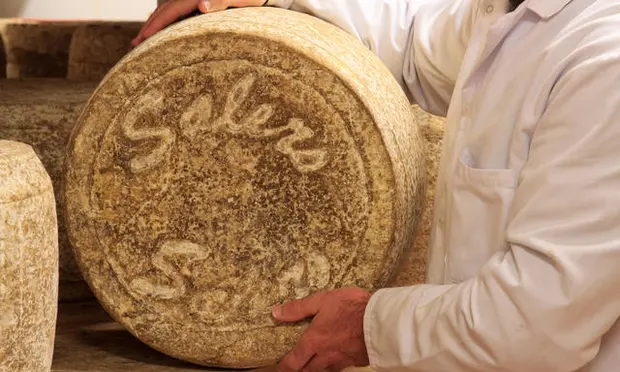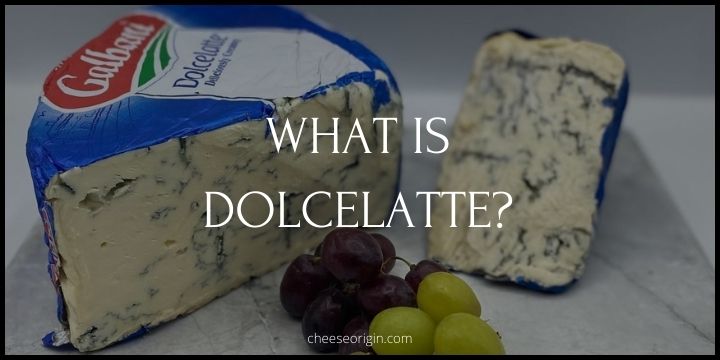What is Salers Cheese? A Flavorful Journey into France’s Cantal Mountains

Welcome, cheese lovers and culinary adventurers, to a flavorful journey that will transport you to the rustic, verdant landscapes of France’s Cantal Mountains. In this corner of the world, where rugged terrain meets serene beauty, a gastronomic gem has been crafted for centuries – Salers Cheese.
This isn’t just another cheese on the board; it’s a story of tradition, a testament of time, and a tribute to the harmony between nature and human craftsmanship. In this blog post, we will delve into the rich tapestry of Salers Cheese, a delicacy shaped by its unique terroir, milked from the native Salers cows, and nurtured by the hands of dedicated farmers.
Quick Facts About Salers Cheese
| Quick Fact | Details |
|---|---|
| Origin | Originates from the Cantal Mountains in the Auvergne region of France. |
| Cheese Type | Semi-hard, uncooked, pressed cheese made from cow’s milk. |
| Production Season | The production of Salers cheese is strictly regulated and is only produced between April 15 and November 15 when cows are grazing on fresh mountain pastures. |
| Ageing Process | Typically aged for at least three months, but some varieties can be aged up to 18 months. |
| Unique Feature | One of the few cheeses that must still be made in a traditional wooden “gerle” or tub. |
| Taste | Complex flavor profile with notes of grass, hay, nuts, and often a hint of spiciness. It becomes more robust and tangy as it ages. |
| Texture | Dense and firm, with a rich, creamy mouthfeel. |
| Pairings | Pairs well with full-bodied red wines and rustic, hearty bread. |
| Nutritional Value | High in protein, calcium, and vitamins A and B. |
| Designation | Granted Protected Designation of Origin (PDO) status by the European Union, ensuring that only cheese produced in the specific region and using the traditional method can be called Salers. AOC: 1961, AOP: 2003 |
What is Salers Cheese?

Nestled within the rugged beauty of France’s Cantal Mountains, a gastronomic treasure awaits discovery – Salers cheese. This semi-hard, artisanal cheese, hailing from the Auvergne region, is steeped in tradition and history. Its origins can be traced back to the 17th century, making it one of the oldest cheeses in France.
What sets Salers apart from other cheeses is its unique production process. It is made exclusively from the milk of Salers breed cows that graze on the rich, volcanic pastures of the Cantal Mountains. The cheese is produced only between April 15 and November 15, when the cows are out on the pastures, ensuring that the milk used is of the highest quality, imbued with the flavors of the diverse flora found in these high-altitude meadows.
The magic doesn’t stop there. Salers cheese must be made in a traditional wooden ‘gerle’ or tub, a practice that has been followed for centuries. This imparts a distinctive microbial influence, contributing to its unique flavor. Once formed, the cheese wheels are aged for at least three months, developing a natural rind under the watchful eyes of master cheesemakers. Some variants are aged up to 18 months, deepening their complexity.
Protected by the European Union’s Protected Designation of Origin (PDO) status, every wheel of Salers cheese is a testament to the region’s rich heritage and the timeless art of cheese-making. Whether enjoyed on its own, paired with rustic bread, or savored with a full-bodied red wine, Salers cheese is a culinary journey that promises to intrigue and delight.
What Does Salers Cheese Taste Like?
Salers cheese offers a rich and complex flavor profile that is sure to delight the palates of cheese enthusiasts. The taste of Salers is unique, varying slightly depending on the specific flora where the cows grazed. It embodies aromatic notes of grass, hay, and nuts, with a distinctive hint of hazelnut and citrus butter.
As the cheese matures, it develops more dynamic tastes, including pungent, musky, woody, and smoky notes. The interior of Salers is a rich yellow color, exuding fruity aromas. Its taste is nutty, spicy, and intense, often reminiscent of raw onions, wildflowers, and grass. Some even describe it as having a bold, beefy, savory flavor, with a doughy element suggesting a hint of hops.
The cheese’s crust is thick and has a grey color, while its pâte is firm, yellow, and relatively hard, with a fruity smell. Salers cheese also has a strong raw-onion bite, adding to its character. Despite its firm texture, Salers is slightly crumbly, providing a delightful contrast in every bite.
Salers Cheese Tasting Notes

- Appearance: Salers cheese is distinct with its natural, thick, grey rind. The interior or pâte of the cheese is a rich, vibrant yellow. It’s firm yet slightly crumbly, providing a delightful contrast.
- Aroma: The aroma of Salers cheese is a testament to the lush pastures where the cows graze. There are notes of raw onion, wildflowers, grass, and fruits that can be detected in its scent.
- Flavor: The flavor of Salers cheese is quite complex. Initially, you’ll notice a nutty taste, which then progresses to a spicy and intense flavor. The cheese develops a bold, beefy, savory flavor as it ages, with a doughy note suggestive of hops.
- Texture: Despite its firm appearance, Salers cheese has a slightly crumbly texture. The mouthfeel is rich and creamy, providing a satisfying experience with every bite.
- Aftertaste: The aftertaste of Salers cheese lingers on the palate, leaving behind a mellow spiciness and a hint of the grassy pastures from which it originates.
- Pairing Suggestions: Salers pairs well with full-bodied red wines, rustic breads, and fruits like apples and pears. It can also be enjoyed with cured meats for a hearty snack.
- Best Use: Salers cheese is versatile and can be used in a variety of culinary applications. It’s excellent in salads, on cheese boards, melted in casseroles, or simply enjoyed on its own.
How is Salers Cheese Made?
- Grazing: Salers cows are allowed to graze freely on the lush, volcanic pastures of the Auvergne region in France. This diet, rich in diverse flora, contributes to the unique flavor profile of Salers cheese.
- Milking: The cows are milked once a day, and only by hand. This traditional method is said to contribute to the quality of the milk.
- Raw Milk Collection: The raw milk is collected in a traditional wooden vat called a ‘gerle’. The milk begins to ferment naturally due to the lactic acid bacteria present in the gerle.
- Coagulation: The milk is left to coagulate for several hours, forming curds.
- Cutting the Curd: The curd is cut into small grains, releasing whey. The size of the grains can affect the final texture of the cheese.
- Molding and Pressing: The curds are transferred into molds and pressed to remove more whey and help the curds knit together.
- Salting: The cheese is then salted to enhance flavor and aid in preservation.
- Aging: The cheese wheels are aged in cool, humid cellars for at least three months, although many are aged much longer. During this time, they develop their distinctive grey rind and complex flavor.
- Packaging and Distribution: Once the cheese has matured, it is ready to be packaged and distributed to shops and customers around the world.
Also read: The Science of Cheesemaking: A Journey from Milk to Artisanal Delight
How to Eat Salers Cheese?
Salers cheese is versatile and can be enjoyed in a number of ways:
- With Fruits: Pairing Salers cheese with fruits like grapes and pears enhances its flavor. The sweetness of the fruit complements the savory, nutty taste of the cheese.
- With Nuts: Pairing with nuts, particularly walnuts. The crunchiness of the nuts contrasts nicely with the slightly crumbly texture of the cheese.
- With Bread: Salers cheese also goes well with bread. You can enjoy it as part of a cheese board or even on its own as a simple, satisfying snack.
- As Part of a Meal: Salers cheese has a hard, slightly crumbly texture similar to cheddar, making it a great choice for sandwiches, salads, and casseroles.
- Wait Before Eating: Cut off a wedge and wait an hour or so before eating to allow the cheese to reach room temperature, which can enhance its flavor.
- Pair with Local Foods and Drinks: If you’re in Salers, we recommend trying local foods and drinks along with Salers cheese. For example, you might pair it with Fouchtra, another type of cheese, or Avèze, a herbal liqueur.
10 Best Salers Cheese Substitutes
| Substitute | Description |
|---|---|
| Cantal | Similar to Salers but slightly less complex in flavor. It’s also made in the Auvergne region of France. |
| Cheddar | A widely available, hard, and slightly sharp cheese that can work as a good substitute in many recipes. |
| Gruyère | A Swiss cheese that has a slightly nutty, sweet flavor. It’s a good melting cheese, making it a suitable substitute in cooked dishes. |
| Comté | A French cheese with a nutty, slightly sweet flavor. It’s similar in texture to Salers and makes a good alternative. |
| Beaufort | Another cheese from the Alps, it has a smooth texture and a flavor that ranges from sweet to sharp. |
| Emmental | This Swiss cheese is known for its distinctive holes and slightly sweet, nutty flavor. It’s a good melting cheese like Salers. |
| Tomme de Savoie | A French cheese with a semi-soft texture and a mildly fruity flavor. It’s a good choice for cheese boards. |
| Raclette | Known for its excellent melting qualities, this Swiss cheese has a creamy, nutty flavor that can stand in for Salers in recipes. |
| Morbier | A French cheese with a line of vegetable ash running through the middle. It has a rich, creamy flavor. |
| Saint Nectaire | A semi-soft, washed rind cheese from the Auvergne region. It has a creamy, mushroomy flavor that could replace Salers in some dishes. |
What Pairs Well With Salers Cheese?

Food that goes well with Salers Cheese:
| Category | Food |
|---|---|
| Fruits | Pears, Apples, Grapes |
| Nuts | Walnuts, Almonds, Pecans |
| Breads | Baguette, Whole Grain Bread, Olive Bread |
| Meats | Prosciutto, Salami, Smoked Turkey |
| Vegetables | Roasted Bell Peppers, Marinated Artichokes, Sun-dried Tomatoes |
| Spreads | Fig Jam, Honey, Quince Paste |
| Seafood | Smoked Salmon, Anchovies, Sardines |
| Other Cheeses | Camembert, Roquefort, Brie |
| Desserts | Dark Chocolate, Dried Fruits, Dessert Biscuits |
Also read: What Fruit Goes on a Charcuterie Board?
Beverage that goes well with Salers Cheese:
| Category | Beverage |
|---|---|
| Wine | Cabernet Sauvignon, Merlot, Pinot Noir |
| Beer | Stout, Brown Ale, Belgian Tripel |
| Spirits | Whiskey, Brandy, Bourbon |
| Non-Alcoholic | Apple Cider, Grape Juice, Herbal Tea |
Also read: Best Wine and Cheese Pairings: The Ultimate Guide
The History of Salers Cheese

Salers cheese is a traditional, farmhouse, unpasteurized, semi-hard cheese that originated in the Cantal mountains of the Massif Central, in the Auvergne region of France. It’s made from the milk of Salers cows, which are a breed native to this region. Salers cheese is unique in that it’s a type of pressed uncooked cheese. This means that it’s made by pressing the curd to remove whey without cooking or heating it beforehand.
The history of Salers cheese dates back to ancient times, with estimations suggesting it has been produced in this region for at least 2,000 years. The cheese-making process was initiated by the people living near the Salers village, who had a passion for cheese-making. Every spring, they would take their cows to the mountain pastures to graze on the rich and diverse flora, which contributes to the distinctive flavor of Salers cheese.
One interesting feature of Salers cheese production is that the raw whole milk must be processed on the farm, immediately after milking. This practice helps preserve the freshness and quality of the milk, which directly influences the final product. Another important factor is that the Salers cow only gives milk if her calf is present, which further complicates the production process.
Over time, Salers cheese has become one of the most traditional cheeses of France. It’s often compared to and confused with Cantal cheese due to their similar origins and characteristics. However, Salers is distinguished by certain features like its exclusively farm-produced nature and specific production period: it is produced exclusively from Salers cow’s raw milk collected between April 15 and November 15.
Also read:
- What is Stracchino (Crescenza)? The Creamy Treasure of Northern Italy
- What is Morbier? The Tale of a Two-Layered Cheese
- What is Langres? Tasting the Unique Flavor of Champagne Ardenne
- What is Chevrotin? The Savory Secret of Savoie
- What is Livarot Cheese? The Pungent Delight from Normandy
- What is Reblochon de Savoie? A Taste of the French Alps
- What is Vacherin Mont d’Or? The ‘Holy Grail’ of Soft Cheeses





